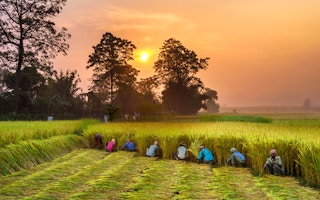Development experts and policymakers understandably focus on migration to urban areas and the need for sustainable urbanization. But they should not lose sight of the dramatic changes happening in rural areas, which are too often ignored.
To continue reading, subscribe to Eco‑Business.
There's something for everyone. We offer a range of subscription plans.
- Access our stories and receive our Insights Weekly newsletter with the free EB Member plan.
- Unlock unlimited access to our content and archive with EB Circle.
- Publish your content with EB Premium.
While the growing demand for food – driven by rising population and incomes – is creating opportunities for rural people, hunger and poverty remain concentrated in rural parts of developing countries. Unless rural development receives more attention, young people will continue to abandon agriculture and rural areas in search of better livelihoods in cities or abroad.
Last year at the United Nations General Assembly, world leaders adopted the 2030 Agenda for Sustainable Development and the Sustainable Development Goals (SDGs), which include a commitment to “leave no one behind.” And, with the number of forcibly displaced people reaching all-time highs this year, the UN will hold a summit on September 19 to discuss the problem.
But no effort to address the issues surrounding the global surge in migrants and refugees will succeed unless it specifically targets the plight of the world’s rural poor.
According to the World Bank, in 1990, some 37 per cent of people in developing regions lived on less than $1.90 a day. By 2012, 12.7 per cent did, amounting to more than one billion people rising out of extreme poverty.
And yet, inequality between rural and urban areas has increased. Today, three-quarters of the world’s poorest and hungriest people live in rural areas.
Small farms support 2.5 billion people worldwide, accounting for up to 80 per cent of food produced in Asia and Sub-Saharan Africa.
But most smallholder farmers still operate without many of the basic conditions needed to grow their businesses and invest in their communities, such as finance, infrastructure, market access, secure land ownership, and rights to resources.
This means that efforts to transform rural areas must target these institutional factors (along with improving gender equality and safeguarding the rule of law), while also introducing new technologies to local communities. And, most important, rural people themselves must be involved, not only as stakeholders or beneficiaries of aid, but as partners.
“
Unless rural development receives more attention, young people will continue to abandon agriculture and rural areas in search of better livelihoods in cities or abroad.
Two new studies provide important perspectives on the challenge of reducing poverty, hunger, and inequality worldwide. The International Fund for Agricultural Development’s (IFAD) Rural Development Report, to be launched on September 14, compiles new research for policymakers and others working to eradicate poverty.
Leading thinkers analyzed rural-development efforts in more than 60 developing countries, drawing conclusions about what does and doesn’t work.
One central finding is that development focused specifically on rural communities has a major positive impact on incomes, security, and food and nutrition. And these quality-of-life improvements then translate into better education, health care, and other critical services. At the same time, these gains have not been evenly distributed, and Sub-Saharan Africa has seen far less progress than other areas.
The second study, funded by IFAD and recently released by the International Food Policy Research Institute, examines the worldwide economic downturn starting in 2012 in the context of rural populations. It finds that as a result of the downturn, 38 million more people will remain in extreme poverty in 2030 than likely would have otherwise, with farm households in middle-income countries particularly at risk.
This poses a serious challenge for the SDGs to end poverty “in all its forms everywhere,” and it strengthens the case for policies and investments specifically targeting rural areas, which is where poverty-reduction measures are needed more and will have a larger impact.
Rural areas’ progress so far reveals their future potential. In many cases, their economies have diversified and become more dynamic, and new roads and communication networks have reduced the physical and cultural distance between rural and urban residents. In small towns and villages, new types of societies are evolving wherein agriculture, while still important, is no longer the only thing that defines economic and cultural life.
It is time to look at development more holistically, acknowledging that rural development and urban development are not mutually exclusive – each needs the other. If we neglect rural areas, persistent poverty and hunger will continue to drive migration flows, not only to urban areas, but also to neighboring and nearby countries and destinations farther abroad.
Leaving rural areas behind will not move developing countries forward; on the contrary, for many, it threatens to throw the engines of progress into reverse.
Kanayo F. Nwanze is President of the International Fund for Agricultural Development (IFAD) and the first recipient of the Africa Food Prize.
Copyright: Project Syndicate, 2016.
www.project-syndicate.org









